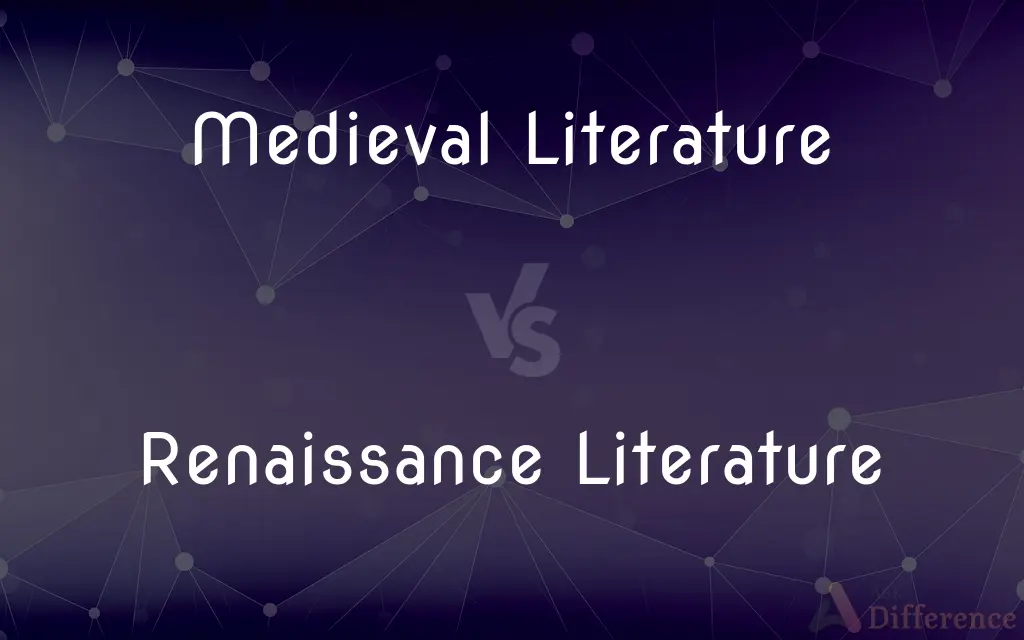Medieval Literature vs. Renaissance Literature — What's the Difference?
Edited by Tayyaba Rehman — By Fiza Rafique — Published on December 28, 2023
Medieval Literature focuses on religious themes and feudal society, while Renaissance Literature emphasizes humanism, exploration, and classical revival.

Difference Between Medieval Literature and Renaissance Literature
Table of Contents
ADVERTISEMENT
Key Differences
Medieval Literature and Renaissance Literature represent two distinct periods in literary history, each with its unique characteristics and values. They're products of their respective eras, reflecting the beliefs, struggles, and aspirations of their times.
Medieval Literature emerged in the Middle Ages, a period dominated by feudalism, chivalry, and the pervasive influence of the Church. As such, much of this literature is deeply religious, exemplified by works like Dante's "Divine Comedy." In contrast, Renaissance Literature coincided with a "rebirth" of interest in the arts, sciences, and classical knowledge. Authors of this period, like Shakespeare, were more concerned with human experiences and the exploration of the natural world.
The language used in Medieval Literature was largely influenced by Latin, the Church's official language, and vernacular tongues like Old English. This linguistic foundation paved the way for the Early Modern English of Renaissance Literature, which was becoming standardized and enriched by borrowings from other languages.
Structurally, Medieval Literature is known for its epic poems, allegories, and religious texts. Stories often revolved around heroes, saints, or moral lessons. On the other hand, Renaissance Literature diversified into sonnets, plays, and prose, diving deep into human emotions, conflicts, and societal observations.
To sum it up, while Medieval Literature encapsulated the religious fervor and hierarchical structure of the Middle Ages, Renaissance Literature marked a turn towards individualism, worldly exploration, and the rediscovery of classical ideals.
ADVERTISEMENT
Comparison Chart
Primary Themes
Religious devotion, feudal society
Humanism, individualism, classical revival
Language
Influenced by Latin and vernaculars
Early Modern English, linguistic enrichment
Popular Forms
Epic poems, allegories, hagiographies
Sonnets, plays, prose
Typical Content
Heroes, saints, moral lessons
Human experiences, societal observations
Period
Middle Ages (5th-14th century)
14th-17th century
Compare with Definitions
Medieval Literature
Literature from the Middle Ages.
Beowulf is a prime example of Medieval Literature.
Renaissance Literature
Literature from the period of cultural "rebirth".
Shakespeare's works are central to Renaissance Literature.
Medieval Literature
Focused on religious themes.
Dante's 'Divine Comedy' epitomizes the religious depth of Medieval Literature.
Renaissance Literature
Emphasizes humanism and individualism.
Erasmus's 'Praise of Folly' reflects the humanistic spirit of Renaissance Literature.
Medieval Literature
Rooted in traditional and religious values.
The morality plays reflect the ethical imperatives of Medieval Literature.
Renaissance Literature
Explores human experiences and nature.
Marlowe's 'Doctor Faustus' delves deep into human ambition, a theme common in Renaissance Literature.
Medieval Literature
Incorporates feudal and chivalric codes.
Chivalric romances are iconic genres within Medieval Literature.
Renaissance Literature
Features diverse forms and innovative styles.
The sonnet was a favored form in Renaissance Literature, with poets like Petrarch leading the way.
Medieval Literature
Rich in allegory and moral lessons.
Every tale in 'The Canterbury Tales' adds a layer to the tapestry of Medieval Literature.
Renaissance Literature
Inspired by classical Greek and Roman works.
The rediscovery of Aristotle influenced many authors in Renaissance Literature.
Common Curiosities
Is Beowulf considered Medieval Literature?
Yes, "Beowulf" is a classic example of Medieval Literature.
Was religion significant in Medieval Literature?
Absolutely, religious themes and moral lessons dominated much of Medieval Literature.
Which language was prominent in Medieval Literature?
Medieval Literature was influenced by Latin and various vernacular languages like Old English.
When did Medieval Literature emerge?
Medieval Literature emerged during the Middle Ages, roughly from the 5th to the 14th century.
What characterizes Renaissance Literature?
Renaissance Literature is marked by humanism, classical revival, and exploration of human experiences.
Who are some famous Renaissance Literature authors?
Shakespeare, Marlowe, and Erasmus are among the notable authors of Renaissance Literature.
Did Renaissance Literature focus on individualism?
Yes, Renaissance Literature often emphasized individual experiences, emotions, and aspirations.
How did the language of literature evolve from medieval to Renaissance times?
While Medieval Literature leaned on Latin and vernaculars, Renaissance Literature saw the rise and enrichment of Early Modern English.
How do the two literary periods reflect their respective societal values?
Medieval Literature mirrors the religious fervor and feudal society of its time, while Renaissance Literature reflects a turn towards individualism and classical ideals.
How did the Renaissance influence literature?
The Renaissance brought a renewed interest in classical knowledge, humanism, and exploration, greatly influencing literature of the period.
Are chivalric romances part of Medieval Literature?
Yes, chivalric romances are iconic genres within Medieval Literature.
Did both periods produce plays?
Yes, though the nature and themes of plays varied, with morality plays being popular in medieval times and diverse theatrical works emerging in the Renaissance.
Were ancient Greek and Roman works influential in Renaissance Literature?
Absolutely, the rediscovery of classical works heavily inspired authors during the Renaissance.
What forms were popular in Renaissance Literature?
Sonnets, plays, and prose were particularly popular during the Renaissance.
Did Medieval Literature have any non-religious works?
While religious themes were prevalent, Medieval Literature also included secular tales and chivalric romances.
Share Your Discovery

Previous Comparison
PTO at Walmart vs. PPTO at Walmart
Next Comparison
BSc vs. BEngAuthor Spotlight
Written by
Fiza RafiqueFiza Rafique is a skilled content writer at AskDifference.com, where she meticulously refines and enhances written pieces. Drawing from her vast editorial expertise, Fiza ensures clarity, accuracy, and precision in every article. Passionate about language, she continually seeks to elevate the quality of content for readers worldwide.
Edited by
Tayyaba RehmanTayyaba Rehman is a distinguished writer, currently serving as a primary contributor to askdifference.com. As a researcher in semantics and etymology, Tayyaba's passion for the complexity of languages and their distinctions has found a perfect home on the platform. Tayyaba delves into the intricacies of language, distinguishing between commonly confused words and phrases, thereby providing clarity for readers worldwide.













































